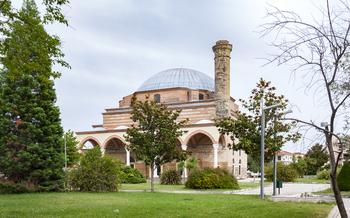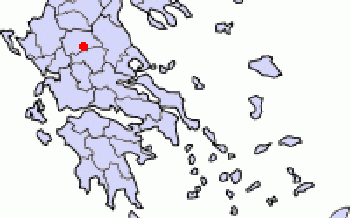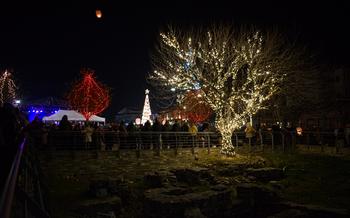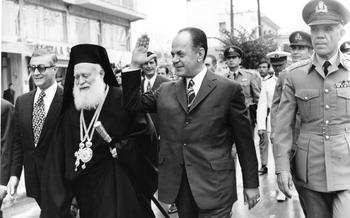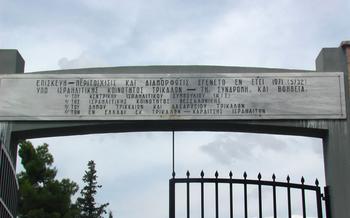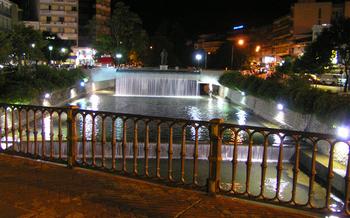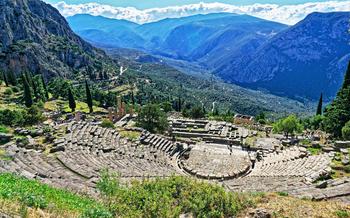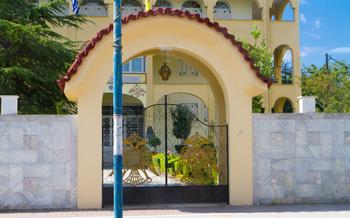
Varousi Old Town
- Historical Background
- Thessalian Plain
- Varousi Old City
- Folklore Museum
- Church of Agios Nikolaos
- Trikalon Castle
- Archaeological Museum of Trikala
- Asclepieion of Trikala
- Trikala Municipal Park: a green oasis in the heart of the city
- Mills of Agia Paraskevi
- Mount Koziakas: A Haven for Outdoor Enthusiasts
- Meteora: A Heavenly Experience
- Trikala Carnival: A Celebration of Merriment and Tradition
- Tsipouro Festival: A Celebration of the Local Spirit
- Insider Tip:
Historical Background
Trikala, a city in central Greece, boasts a rich and captivating history dating back to ancient times. In the 4th century BC, Trikala was part of the kingdom of Epirus, ruled by the renowned Pyrrhus of Epirus. During the Roman period, the city flourished as a significant trade and cultural center. Its strategic location on the Thessalian Plain made it a vital hub for commerce and transportation.
Trikala's historical monuments, including the 14th-century Trikalon Castle and the 10th-century Church of Agios Nikolaos, stand as testaments to its storied past. These landmarks offer a glimpse into the city's Byzantine and Ottoman heritage, showcasing its architectural prowess and artistic achievements. Throughout the centuries, Trikala has undergone significant transformations, evolving from an ancient settlement to a vibrant modern city while retaining its unique charm and cultural identity.
Thessalian Plain
Trikala is situated in the heart of Central Greece, in the fertile Thessalian Plain. Being the largest city in Thessaly, it serves as a gateway to the majestic Pindus Mountains, which form a natural border between Thessaly and Epirus. Trikala's strategic location has made it a significant crossroads since ancient times, connecting the north and south of Greece, as well as the east and west.
The Thessalian Plain is renowned for its agricultural abundance, with fertile soil and a favorable climate that has supported farming and agriculture for centuries. Trikala, as the region's main urban center, has benefited from this agricultural wealth, becoming a prosperous and thriving city. Its central location has also made it a hub for trade and commerce, further contributing to its economic development and growth.
Varousi Old City
The Varousi Old City is a must-see for any visitor to Trikala. With its well-preserved 13th-century city walls, cobblestone streets, and traditional architecture, it's like stepping back in time. Many of the buildings in the old city have been converted into shops, restaurants, and cafes, making it a great place to wander around and soak up the atmosphere.
The old city is also home to several historical monuments, including the Church of Agios Nikolaos, the Trikalon Castle, and the Folklore Museum. The Church of Agios Nikolaos is a Byzantine church that was built in the 10th century and is known for its impressive frescoes. The Trikalon Castle is a Byzantine fortress that was built in the 14th century and offers panoramic views of the city. The Folklore Museum is housed in a 19th-century mansion and features exhibits on the history and culture of Trikala.
If you're looking for a place to experience the real Trikala, then the Varousi Old City is the place to go. With its narrow streets, whitewashed houses, and friendly locals, it's easy to see why this is one of the most popular tourist destinations in Trikala.
Folklore Museum
Housed in the stately atmosphere of a meticulously restored 19th-century mansion, the Folklore Museum of Trikala invites visitors to embark on a journey through time, unveiling the rich cultural tapestry of this captivating region. Within its walls, an impressive collection of archaeological and ethnographic treasures awaits, narrating the story of Trikala's past and its deep-rooted connection to tradition.
The museum's archaeological section takes visitors on an exploration of the region's ancient heritage, showcasing artifacts unearthed from excavations conducted throughout Trikala and its surroundings. From Neolithic tools to intricate pottery and finely crafted jewelry, each piece offers a glimpse into the lives and customs of the people who once called this land home.
Complementing the archaeological exhibits, the museum's ethnographic collection delves into the cultural traditions and customs that have shaped the identity of Trikala. Traditional costumes, intricately woven textiles, and household items provide a vivid portrayal of everyday life in the region. Visitors can admire the exquisite craftsmanship and artistry that went into creating these objects, each one a testament to the skill and creativity of local artisans.
To further enrich the visitor experience, the museum hosts rotating art exhibitions, showcasing the works of both established and emerging artists from Trikala and beyond. These exhibitions provide a platform for contemporary artistic expression, offering visitors the opportunity to engage with the vibrant creative scene of the city.
Church of Agios Nikolaos
The Church of Agios Nikolaos, a testament to the city's rich Byzantine heritage, is nestled within the heart of the Varousi Old Town. Its foundation dates back to the 10th century, making it one of the oldest churches in Trikala. Constructed entirely of stone, the church exudes an aura of antiquity and resilience.
Step inside to marvel at the breathtaking frescoes that adorn the walls and ceilings. These intricate works of art depict scenes from the Bible and the lives of various saints, offering a glimpse into the religious devotion of the time. The vibrant colors and expressive figures seem to come alive, inviting viewers on a spiritual journey through history.
The Church of Agios Nikolaos is not only a place of worship but also a symbol of Trikala's cultural heritage. It stands as a reminder of the city's deep-rooted Byzantine traditions and the enduring influence of Christianity in shaping its identity.
Trikalon Castle
The Trikalon Castle, also known as history. Constructed in the 14th century, this imposing Byzantine fortress played a crucial role in defending the region against invaders. Its strategic location atop a hill overlooking the city provided a commanding view of the surrounding area.
The castle's construction involved the use of local stone, giving it a distinct and rustic appearance. Its massive walls, fortified with towers and battlements, provided a formidable defense system during times of conflict. Over the centuries, the castle underwent several modifications and additions, reflecting the changing needs and influences of successive rulers.
Today, the Trikalon Castle stands as a symbol of Trikala's resilience and cultural heritage. Visitors can explore its well-preserved ruins, wander through its courtyards, and climb to the top of its towers to enjoy breathtaking panoramic views of the city and the surrounding landscape. The castle also serves as a venue for cultural events and performances, adding to its vibrancy and significance.
Archaeological Museum of Trikala
The Archaeological Museum of Trikala is a treasure trove of ancient artifacts that narrate the captivating story of human civilization in the region. Situated in the heart of the city, this museum houses a diverse collection of archaeological finds spanning from the Neolithic era to the Roman period.
As you step into the museum's elegant halls, you'll be greeted by an array of exhibits that showcase the region's rich history. From intricately crafted stone tools and pottery shards to stunning sculptures and inscriptions, each artifact tells a unique tale of the people who once inhabited this land.
The museum's collection is particularly renowned for its impressive array of artifacts from the Neolithic period. Here, you'll find a glimpse into the lives of early settlers who lived in the Thessalian plain thousands of years ago. Discover their ingenious tools, marvel at their finely crafted pottery, and gain insights into their daily lives and rituals.
As you journey through the museum, you'll also encounter captivating exhibits from the Bronze Age, the Iron Age, and the Classical period. Admire exquisite bronze figurines, intricate jewelry, and impressive weaponry that reveal the artistic prowess and technological advancements of ancient civilizations.
One of the highlights of the museum is the collection of ancient coins. These numismatic treasures offer a fascinating glimpse into the economic and political systems of the past. Examine coins minted by various city-states and empires, each bearing unique symbols and inscriptions that tell stories of trade, power, and cultural exchange.
The Archaeological Museum of Trikala is not just a repository of ancient artifacts; it's a gateway to the past, inviting you to explore the rich tapestry of human history in the Thessalian region. Through its interactive exhibits and knowledgeable staff, the museum brings the ancient world to life, providing visitors with an immersive and educational experience.
Asclepieion of Trikala
The Asclepieion of Trikala was an ancient healing center dedicated to the Greek god of medicine, Asclepius. It was built in the 4th century BC and was one of the most important medical centers in ancient Greece. The Asclepieion was located on the outskirts of the ancient city of Trikala, in a beautiful and tranquil setting. It consisted of a temple, a hospital, and a theater. The temple was dedicated to Asclepius and was used for religious ceremonies and healing rituals. The hospital was where patients were treated and cared for. The theater was used for lectures and performances related to medicine and healing.
The Asclepieion of Trikala was a place where people from all over Greece came to seek healing and relief from their ailments. The priests of Asclepius were renowned for their medical skills and their ability to perform miraculous cures. The Asclepieion was also a center of medical research and education. Physicians from all over Greece came to study and learn from the priests of Asclepius.
Today, the ruins of the Asclepieion of Trikala are still visible and are a popular tourist attraction. The site includes the remains of the temple, the hospital, and the theater. Visitors can also see the foundations of the ancient baths and the palestra, where patients exercised and received physical therapy. The Asclepieion of Trikala is a reminder of the importance of medicine and healing in ancient Greece and is a testament to the skill and dedication of the priests of Asclepius.
Trikala Municipal Park: a green oasis in the heart of the city
Trikala Municipal Park is a sprawling green oasis that offers a welcome respite from the hustle and bustle of city life. Located in the heart of Trikala, the park is a popular destination for locals and tourists alike, offering a variety of recreational activities and attractions.
The park's lush grounds are dotted with walking paths, playgrounds, and a tranquil lake, providing ample opportunities for relaxation and recreation. Visitors can take a leisurely stroll along the tree-lined paths, enjoying the fresh air and the park's natural beauty. For those seeking more active pursuits, there are playgrounds for children, as well as basketball and volleyball courts for adults.
In addition to its recreational offerings, Trikala Municipal Park is also a cultural hub, hosting a variety of events throughout the year. From concerts and art exhibitions to festivals and celebrations, the park is a vibrant space that brings the community together.
One of the highlights of the park is its annual music festival, which attracts renowned artists from around the world. The festival features a diverse lineup of musical genres, from traditional Greek music to rock, pop, and electronic music.
Another popular event is the park's food festival, which showcases the culinary delights of the region. Visitors can sample a variety of traditional Greek dishes, as well as international cuisine, while enjoying live music and entertainment.
Trikala Municipal Park is a must-visit destination for anyone visiting Trikala. Whether you're looking for a place to relax and unwind, enjoy some outdoor activities, or experience the city's vibrant cultural scene, the park has something to offer everyone.
Mills of Agia Paraskevi
Just a short walk from the Varousi Old Town, along the banks of the Trikala River, you'll find the picturesque Mills of Agia Paraskevi. These traditional watermills, with their large millstones and wooden structures, are a testament to the city's rich history and connection to the land.
Once used to grind wheat and corn, the mills have been beautifully restored and now serve as a popular tourist attraction. Visitors can wander through the mill complex, learning about the history and operation of these ingenious machines. Some of the mills are still operational, and visitors can even catch a glimpse of the milling process in action.
The Mills of Agia Paraskevi offer a unique and immersive experience, transporting visitors back in time to a simpler way of life. Surrounded by lush greenery and the sound of the flowing river, it's easy to imagine the hustle and bustle of the mills when they were in full operation.
Whether you're interested in history, engineering, or simply looking for a peaceful and picturesque spot to relax, the Mills of Agia Paraskevi are definitely worth a visit.
Mount Koziakas: A Haven for Outdoor Enthusiasts
Mount Koziakas, an awe-inspiring natural wonder, rises majestically just outside the city of Trikala. This mountain, with its verdant slopes and diverse landscapes, beckons outdoor enthusiasts with a plethora of activities to enjoy.
Hikers will find an extensive network of well-maintained trails winding through the mountain's pristine forests and meadows. Whether you prefer a leisurely stroll or a challenging climb, Mount Koziakas has something to offer. As you ascend, the panoramic views of the surrounding countryside and the distant Pindus Mountains will take your breath away.
For those seeking a more exhilarating experience, mountain biking trails of varying difficulty levels crisscross the mountain's terrain. Navigate through dense forests, traverse rocky paths, and conquer steep inclines as you immerse yourself in the unspoiled beauty of the natural surroundings.
During the winter months, Mount Koziakas transforms into a skiers' paradise. The well-equipped ski resort offers a range of slopes for both beginners and experienced skiers, along with modern facilities and amenities. Glide down the pristine slopes, surrounded by breathtaking vistas, and experience the thrill of winter sports amidst nature's grandeur.
In addition to these activities, Mount Koziakas also offers opportunities for rock climbing, spelunking, and paragliding. With its diverse terrain and stunning scenery, this mountain is a true playground for adventure seekers and nature lovers alike.
Meteora: A Heavenly Experience
A short drive from Trikala, you'll find yourself in a place that seems straight out of a fairytale - Meteora. This UNESCO World Heritage Site is home to a complex of monasteries perched atop towering rock formations that defy gravity. The monasteries, which were built in the 14th and 15th centuries, served as a refuge for monks seeking solitude and protection from invaders.
Meteora is a place of breathtaking beauty and spiritual significance. The monasteries, with their intricate frescoes and stunning views, offer a glimpse into a bygone era. Visitors can explore the monasteries, hike along the trails, and take in the panoramic views of the surrounding countryside. It's an experience that will stay with you long after you leave.
Insider Tip:
- For a truly unforgettable experience, visit Meteora at sunrise or sunset. The golden light casts a magical glow on the monasteries, creating a scene that is simply breathtaking.
Trikala Carnival: A Celebration of Merriment and Tradition
Trikala Carnival, one of the most renowned and boisterous carnivals in Greece, is a spectacle that captivates the hearts of locals and visitors alike. This vibrant celebration, held annually in February or March, transforms the city of Trikala into a kaleidoscope of colors, music, and infectious energy.
The carnival's origins can be traced back to ancient Dionysian festivals, where revelers would don masks and engage in exuberant dancing and feasting to honor the Greek god of wine and revelry. Over the centuries, the Trikala Carnival has evolved into a unique blend of ancient traditions and contemporary expressions of joy and creativity.
During the carnival, the streets of Trikala burst into life as colorful parades wind their way through the city, showcasing elaborate costumes, whimsical floats, and troupes of performers. The air reverberates with the infectious rhythms of brass bands, and the city's squares become vibrant dance floors, where locals and visitors alike join in the revelry.
One of the highlights of the Trikala Carnival is the Grand Parade, a spectacle that attracts thousands of spectators. Floats of extraordinary artistry, adorned with intricate designs and vibrant colors, roll through the city, accompanied by marching bands, costumed performers, and enthusiastic crowds.
The carnival also features a variety of cultural events, concerts, and exhibitions, catering to diverse tastes and interests. From traditional Greek music performances to contemporary art installations, there's something for everyone to enjoy.
The Trikala Carnival is a testament to the city's rich cultural heritage and its people's zest for life. It's an occasion for unbridled merriement, where inhibitions are shed, and the spirit of joy and camaraderie reigns supreme.
Tsipouro Festival: A Celebration of the Local Spirit
Tsipouro, a traditional Greek spirit distilled from grapes, is deeply ingrained in the cultural fabric of Trikala. Each October, the city comes alive with the Tsipouro Festival, a vibrant celebration that pays homage to this beloved beverage.
During the festival, the streets of Trikala transform into a lively stage, filled with the sounds of traditional music and the aroma of delicious food. Local producers from across the region gather to showcase their finest tsipouro creations, offering visitors the chance to sample and savor the distinct flavors of this unique spirit.
In addition to the tsipouro tasting, the festival features a host of other attractions, including traditional dance performances, live music concerts, and culinary demonstrations. Visitors can indulge in mouthwatering local delicacies, learn about the history and production of tsipouro, and immerse themselves in the rich cultural traditions of the region.
The Tsipouro Festival is a vibrant and unforgettable event that offers a unique glimpse into the heart of Trikala's culinary and cultural heritage. Whether you're a tsipouro enthusiast or simply looking for an authentic Greek experience, this festival is a must-attend.
Insider Tip:
To fully experience the charm of Varousi Old City, consider visiting it at night. As darkness falls, the city transforms into a vibrant hub of activity. The streets come alive with locals and tourists alike, strolling along the cobblestone paths and enjoying the lively atmosphere.
Numerous bars, tavernas, and restaurants open their doors, offering a wide variety of culinary delights and traditional Greek music. You can savor the flavors of local cuisine, sip on refreshing drinks, and immerse yourself in the city's infectious energy. Whether you prefer a quiet evening of people-watching or dancing the night away at a local club, Varousi Old City at night has something to offer everyone.

